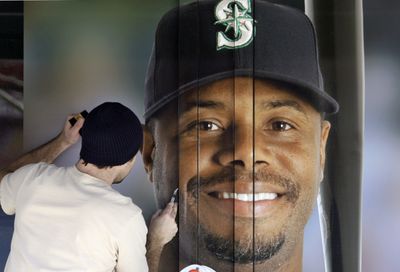Merchants, fans gear up
M’s Griffey is a walking, talking stimulus package

SEATTLE – The framed autographed poster of Ken Griffey Jr. is out of storage and near the entrance of Kirkland Sports Cards off Interstate 405.
Now that Griffey is back in a Mariners uniform, the memorabilia shop’s owner, Marco De La Rosa, thinks the 15-year-old poster will fetch big bucks, even in a terrible economy, and has marked it up a third to $375.
“There’s a lot of pent-up demand in Seattle for a hero, and Ken Griffey Jr. is a hero,” De La Rosa said. “He’s someone kids and parents can look up to – no steroids, no marital problems, no dillydallying at nightclubs. He’s just a great baseball player.”
Griffey, 39, who was 17 when Seattle drafted him in 1987, returned to the M’s last month after leaving for Cincinnati 10 years ago, delighting fans eager to reconnect with the most exciting player in Mariners history.
But whether that delight translates to more sales for business owners such as De La Rosa remains to be seen. The 2009 Major League Baseball season doesn’t begin until next month, and the extent to which merchants benefit from Griffey’s return depends on how many fans flock to see him.
Joe Bernstein owns a hot-dog stand near Safeco Field; for $6, he offers up a half-pound dog called “The Griffey,” or “The Big One.”
“It’s like having Babe Ruth here,” he said. “On opening day, 99 percent of people are going to have a Griffey jersey on, or something with Griffey’s name on it.”
The likely future Hall of Famer – who’s often credited with keeping professional baseball in Seattle and generating public support for Safeco Field’s construction – returns to a team hoping to turn things around after a rough 2008.
Within two days of Griffey’s Feb. 18 announcement, Seattle sold 23,000 tickets through combinations of full- and partial-season packages. Ticket sales have since slowed to a level that a Mariners spokeswoman declined to disclose, saying the team does not provide regular updates. However, tickets for opening day are sold out.
Ticket sales for the M’s spring-training games in Arizona are down 11 percent from a year ago, said spokeswoman Rebecca Hale. She attributes the drop to a widespread travel slump, suggesting fewer fans are making the trip from Seattle to Peoria for an early look at the team.
“I think we’re in the same boat as every entertainment organization,” Hale said. “We’re not the priority for people that a mortgage or gas bill is.”
Attendance
Griffey reportedly signed a one-year contract with the Mariners that entitles him to a base salary of $2 million, plus an additional $3 million if he stays healthy and attendance reaches at least 3 million. The team hasn’t drawn that many people to Safeco Field since 2003.
A total of 2.3 million people turned out for 81 games last year. That represents an average of 28,763, the smallest since 1995 – when the Mariners played in the Kingdome – and a 13 percent decline from 2007. Earlier this week, the Mariners reported a $4.5 million operating loss for the fiscal year that ended Oct. 31, their first deficit since moving to Safeco in 1999.
No doubt, the team’s eventual 101 losses and last-place finish in the American League West Division drove down attendance. Now, rising joblessness and shrinking stock portfolios give fair-weather fans even more reason to pass on paying hundreds or thousands of dollars to see the M’s play, said Eric Fisher, who writes about baseball for SportsBusiness Journal.
After all, tickets aren’t cheap: The Mariners sell full- and half-season passes for as much as $3,645 and $1,800, respectively. Single-game tickets cost $7 to $58, if purchased before April 11.
When it comes to ticket sales, “Most teams are operating under the mantra that flat is the new up,” Fisher said.
“When you win, you sell more. When you lose, you sell less. And the economy is only amplifying those notes on the curve,” Fisher said, adding that Griffey “helps buffer against what might have been a disastrous situation.”
Paul Swangard, who oversees the University of Oregon’s Warsaw Sports Marketing Center, says Griffey’s return helps the Mariners turn the conversation away from last year’s win-loss record to something along the lines of “We’re bringing our favorite son home.”
Focus on Griffey
Matt James, who co-owns a sports-apparel shop called On the Field, says Griffey shirts are about the only non-discounted Mariners items selling these days. The shop offers Griffey T-shirts for $21.95 and jerseys for $100. “We’re anticipating Griffey’s return to be good economically for us,” James said. “Without Griffey, we’d be completely focused on the (Major League Soccer) Sounders right now.”
John Sweeney, who runs the sports-communication program at the University of North Carolina in Chapel Hill, says any sales boost from Griffey’s return could be short-lived.
“If his coming back is transformative for the team’s win-loss record, then it’s a big deal,” Sweeney said. “But if it’s just, ‘Hey, he’s coming back, isn’t that nice?’ – and the team remains in the same place – it’s an event, and then it goes away.”
Mick McHugh, who owns F.X. McRory’s Steak Chop & Oyster House in Pioneer Square, predicts Griffey will draw large crowds to Safeco Field and surrounding businesses. The recession has made for a “long winter,” McHugh said, describing his business as “hanging on by the skinny-skin of our chins. We can hardly wait until opening day.”
And if Griffey struggles?
“He’ll be welcomed regardless,” McHugh said. “His skills have diminished with age, but he is who he is. He’s a leader, and he can have fun with anybody, no matter what country they grew up in, what position they play, or their age. People will come to see him.”